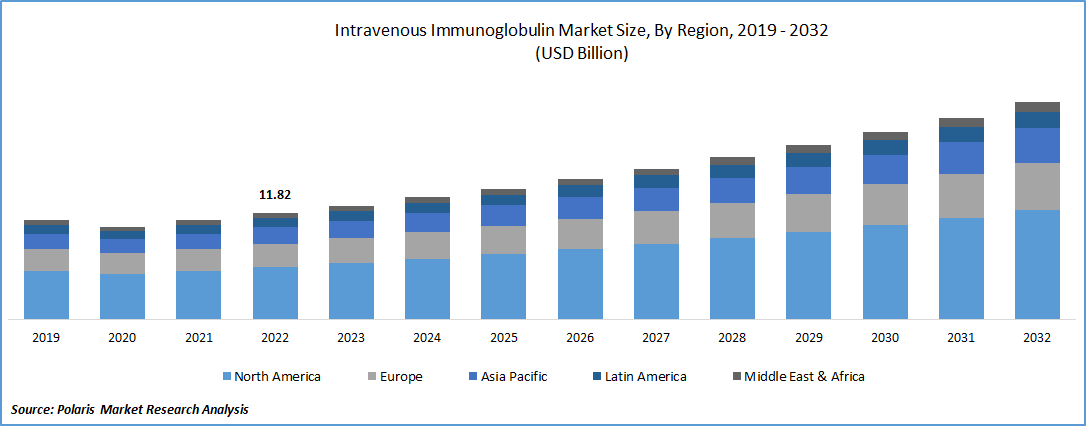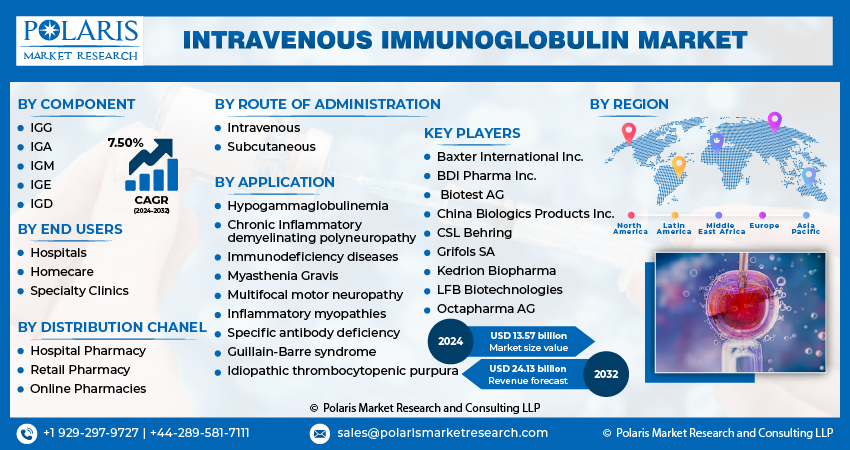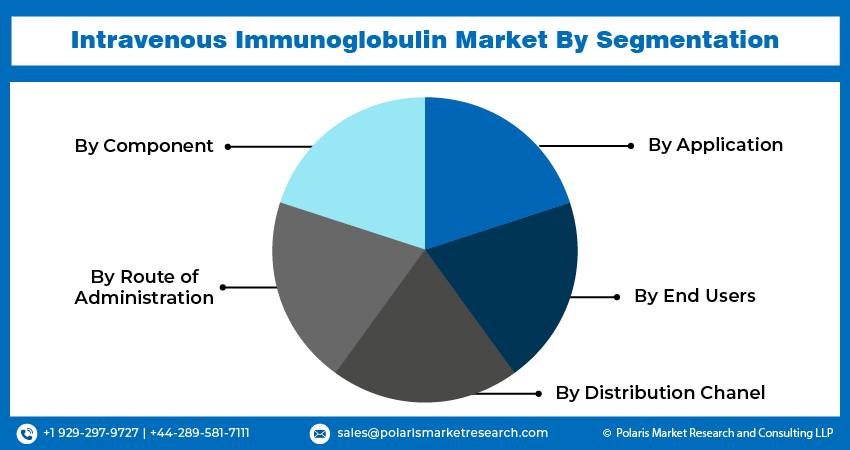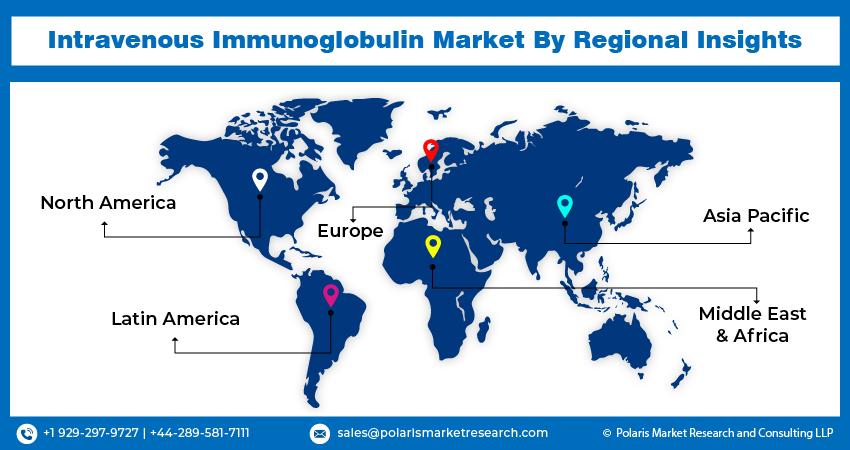
Intravenous immunoglobulin Market Share, Size, Trends, Industry Analysis Report
By Route of Administration (Intravenous, Subcutaneous); By Component; By Application; By End-user; By Distribution Channel; By Region; Segment Forecast, 2024- 2032
- Published Date:Jan-2024
- Pages: 116
- Format: PDF
- Report ID: PM1297
- Base Year: 2023
- Historical Data: 2019-2022
Report Outlook
The global intravenous immunoglobulin market was valued at USD 12.66 billion in 2023 and is expected to grow at a CAGR of 7.50% during the forecast period.
Immunoglobulins, sometimes referred to as antibodies, are glycoprotein molecules that are produced by white blood cells and plasma. Their main function is to detect and bind to specific antigens, such as bacteria and viruses, which helps in getting rid of them from the body. In other words, immunoglobulins play an essential role in our immune system that helps to keep us healthy. The market for immune globulin intravenous (IVIG) therapy has experienced significant growth due to various factors.
The research report offers a quantitative and qualitative analysis of the Intravenous Immunoglobulin Market to enable effective decision-making. It covers the key trends and growth opportunities anticipated to have a favorable impact on the market. Besides, the study covers segment and regional revenue forecasts for market assessment.

To Understand More About this Research: Request a Free Sample Report
These include the increasing prevalence of immune-mediated disorders, advancements in plasma collection and fractionation technologies, and greater awareness among healthcare professionals and patients regarding the benefits of IVIG therapy. The market comprises of several participants, such as pharmaceutical companies that manufacture IVIG products, plasma collection centers, contract manufacturing organizations, distributors, hospitals, clinics, and patients. Major pharmaceutical companies typically have dedicated divisions or subsidiaries that produce and promote IVIG products.
The market for Intravenous Immunoglobulin (IVIG) is highly competitive, with both branded and generic products available. Many companies are actively developing and commercializing IVIG therapies, resulting in a diverse range of products. The market is also influenced by regulatory policies, reimbursement systems, and regional dynamics. The IVIG market is expected to grow due to increasing healthcare expenditure, a rise in the geriatric population, and the expanding off-label use of IVIG. However, the market may face challenges such as the high cost of IVIG therapy, potential side effects, and supply constraints related to plasma availability.
IVIG, a blood product, carries the potential risk of transmitting viral infectious agents. However, only a few cases of hepatitis C transmission have been reported in the distant past. This therapy is a viable option for treating specific infectious diseases that have a significant impact on the immune system. IVIG works by introducing antibodies from healthy individuals into the bloodstream of patients, providing passive immunity. These antibodies can neutralize pathogens, enhance immune responses, and reduce the severity or duration of the infection.

For Specific Research Requirements: Request for Customized Report
Growth Drivers
The Number of People Suffering from Immunodeficiency Disorders Is on the Rise to Drive the Market Growth
The rising prevalence of immunodeficiency disorders can be attributed to several factors, such as the improved diagnostic techniques, increased awareness, and better understanding of these conditions among healthcare professionals. Additionally, advancements in medical treatments and therapies have allowed individuals with immunodeficiency disorders to live longer, leading to an overall increase in cases. A commonly used treatment for individuals with immunodeficiency disorders is immunoglobulin. It is derived from human blood plasma and contains a concentrated dose of antibodies that can help strengthen the immune system. Immunoglobulin is administered intravenously and helps replace or supplement the antibodies in individuals with immunodeficiency.
Report Segmentation
The market is primarily segmented based on component, route of administration, application, end users, distribution channel, and region.
|
By Component |
By Route of Administration |
By Application |
By End Users |
By Distribution Chanel |
By Region |
|
|
|
|
|
|
To Understand the Scope of this Report: Speak to Analyst
By Component Analysis
Igg Segment is Accounted to Be the Largest During Forecast Period
Extensive clinical research has been conducted on IgG, which has led to its widespread use and acceptance in medical practice. Numerous clinical trials have been carried out, demonstrating the effectiveness and safety of IgG in treating various autoimmune disorders, neurological conditions, and other immune-related diseases.
IVIg is a therapy that combines immunoglobulins from multiple donors to treat various disorders. It is administered through an intravenous infusion, which involves a drop into a vein. It can also be given as an injection into a muscle to increase immunoglobulin levels after following other treatments. IVIg is used to alleviate the symptoms of certain inflammatory conditions in the immune system, as well as to boost immunoglobulin levels in cases where they are low or have decreased due to other medications such as rituximab.
By Application Analysis
Immunodeficiency Diseases Segment Accounted for the Largest Market Share in 2022
Immunodeficiency diseases can be classified into two types: primary (inherited) and secondary (acquired). Primary immunodeficiencies are usually genetic and are present from birth, while secondary immunodeficiencies can develop later in life due to factors such as infections, medications, or medical treatments. Patients with primary immunodeficiency diseases such as common variable immunodeficiency, X-linked agammaglobulinemia, and severe combined immunodeficiency are commonly prescribed IVIG therapy. These conditions involve defects in the immune system's ability to produce or effectively utilize antibodies.
Over the years, the occurrence and identification of immunodeficiency diseases have been on the rise. Thanks to enhanced diagnostic methods and increased awareness, more patients with primary immunodeficiencies are being identified. With the better understanding of immunodeficiency diseases and early detection, the demand for therapeutic options such as IVIG has increased. Timely initiation of treatment through prompt and accurate diagnosis has led to better patient outcomes.

By Distribution Channel Analysis
Hospitals Segment Resulted for the Highest Share in 2022
Hospital pharmacies monitor patients receiving intravenous immunoglobulin (IVIG) therapy, collaborate with healthcare professionals to track patient progress, and report any adverse events or reactions to the appropriate regulatory bodies.
The retail pharmacy sector is expected to witness substantial growth in the coming years. Retail pharmacies have a significant role in the IVIG market by providing patients with convenient and easily accessible means of acquiring vital therapies. They work in collaboration with hospitals, healthcare providers, and specialized infusion centers to ensure prompt delivery of IVIG products and related services. In addition to product distribution, retail pharmacies often offer counseling and education to patients about their medication, including details about potential side effects, dosage instructions, and proper storage.
Regional Insights
North America Region Dominated the Global Market in 2022
North America boasts a highly advanced healthcare infrastructure that supports the growth of the IVIG market in the region. With a rising number of cancer patients and the presence of key players such as Baxter International Inc., effective drugs are increasingly introduced into the market. Major pharmaceutical companies in North America invest heavily in research and development, clinical trials, and marketing strategies, driving the growth of the IVIG market. Healthcare professionals and patients in the region are increasingly aware of the benefits of IVIG therapy, leading to early diagnosis and treatment initiation, and boosting demand for IVIG products. The well-developed healthcare infrastructure in North America, including hospitals, clinics, and research facilities, facilitates the widespread adoption of IVIG therapies, thus supporting the growth of the market.
The intravenous immunoglobulin market in the Asia-Pacific region is expected to grow significantly in the upcoming years. The region has a substantial population, including highly populated countries like India and China. Due to this, there is a high demand for IVIG treatment, which in turn drives the market growth. Many local and international pharmaceutical companies are actively producing and distributing IVIG products in the region, leading to a competitive market. This competition stimulates innovation, reduces prices, and increases product availability, further boosting the IVIG market's growth. The intravenous immunoglobulin market in the Asia-Pacific region is also fueled by increasing government support, growing research and development activities, and rising healthcare reforms.

Key Market Players & Competitive Insights
The intravenous immunoglobulin market is fragmented and is anticipated to witness competition due to several players' presence. Major service providers in the market are constantly upgrading their technologies to stay ahead of the competition and to ensure efficiency, integrity, and safety. These players focus on partnership, product upgrades, and collaboration to gain a competitive edge over their peers and capture a significant market share.
Some of the major players operating in the global market include:
- Baxter International Inc.
- BDI Pharma Inc.
- Biotest AG
- China Biologics Products Inc.
- CSL Behring
- Grifols SA
- Kedrion Biopharma
- LFB Biotechnologies
- Octapharma AG
Recent Developments
- In March 2022, Sanofi and Seagen have signed an exclusive collaboration agreement to develop and commercialize up to three antibody-drug conjugates for cancer targets, using Sanofi's monoclonal antibody technology and Seagen's ADC technology.
- In January 2022, Argenx SE is a global immunology company that is dedicated to improving the quality of life for individuals suffering from severe autoimmune diseases. Recently, the Ministry of Health, Labour and Welfare (MHLW) in Japan has approved the use of VYVGART (efgartigimod alfa) intravenous infusion for the treatment of adult patients with generalized myasthenia gravis (gMG) who have not responded well to steroids or non-steroidal immunosuppressive therapies (ISTs).
Intravenous immunoglobulin Market Report Scope
|
Report Attributes |
Details |
|
Market size value in 2024 |
USD 13.57 billion |
|
Revenue Forecast in 2032 |
USD 24.13 billion |
|
CAGR |
7.50% from 2024 – 2032 |
|
Base year |
2023 |
|
Historical data |
2019 – 2022 |
|
Forecast period |
2024 – 2032 |
|
Quantitative units |
Revenue in USD billion and CAGR from 2024 to 2032 |
|
Segments covered |
By Component, By Route of Administration, By Application, By End-User, By Distribution Channel, By Region |
|
Regional scope |
North America, Europe, Asia Pacific, Latin America, Middle East & Africa |
|
Customization |
Report customization as per your requirements with respect to countries, region, and segmentation. |
Seeking a more personalized report that meets your specific business needs? At Polaris Market Research, we’ll customize the research report for you. Our custom research will comprehensively cover business data and information you need to make strategic decisions and stay ahead of the curve
Browse Our Top Selling Reports:
Buccal Drug Delivery System Market Size, Share 2024 Report
Body Fat Reduction Market Size, Share 2024 Report
Anti-Vascular Endothelial Growth Factor Therapeutics Market Size, Share 2024 Report
Veterinary Reference Laboratory Market Size, Share 2024 Report
FAQ's
The intravenous immunoglobulin market report covering key segments are component, Route of Administration, Application, End users, Distribution channel and region.
Intravenous Immunoglobulin Market Size Worth $24.13 Billion By 2032.
The global intravenous immunoglobulin market is expected to grow at a CAGR of 7.4% during the forecast period.
North America is leading the global market.
key driving factors in intravenous immunoglobulin market are • The number of people suffering from immunodeficiency disorders is on the rise.to drive the market growth.
